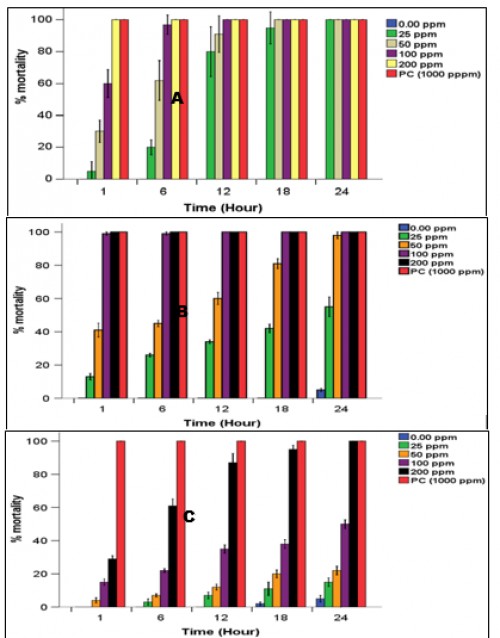Toxic effect of Chenopodium ambrosoides, Hyptis suaveolens and Lippia adoensis leaf methanol extracts and essential oils against fourth instar larvae of Anopheles gambiae (Diptera: Culicidae)
Author(s): Mallam Kary Oumarou, Lame Younoussa and Elias Nchiwan Nukenine
Abstract: Nowadays, controlling insect vectors using plant products is the utmost encouraged in the mosquito pest management to the detriment of synthetic insecticides which are environmentally non-biodegradable and harmful for human and livestock. The present investigation aimed to evaluate the effectiveness of Chenopodium ambrosoides, Hyptis suaveolens, and Lippia adoensis leaf methanolic extracts and essential oils against fourth instar larvae of Anopheles gambiae in the laboratory. Plant extracts were dissolved in 1 ml of methanol and doses of 125, 250, 500 and 1000 ppm for methanol extracts and 200, 100, 50 and 25 ppm for essential oils were prepared in the volume of 100 ml with tap water in the 250 ml plastic cups. Twenty five fourth instar larvae were transferred to each solution dose and larval mortality was recorded after 24 h post-treatment. In results, all the plant products tested have shown their dose-dependent toxic effect against on An. gambiae larvae. Tested at 200 ppm, essential oils of each plant caused 100% mortality of larvae. The essential oil of C. ambrosoides (LC50 = 6 ppm after 18 h) was the most potent compared to H. suaveolens (LC50 = 19.20 ppm) and L. adoensis (LC50 = 75.63 ppm) after 24 h post-exposure. At the highest dose of 1000 ppm, all plant extracts exhibited 100% mortality of An. gambiae larvae. Among the plant extracts, the methanolic extract of L. adoensis with LC50 = 94.71 ppm was revealed to be the most effective compared to H. suaveolens (LC50 = 132.01 ppm) and C. ambrosoides (LC50 = 204.56 ppm) extracts 24 h post-treatment. From these results, H. suaveolens, L. adoensis and C.ambrosoides leaf methanolic extracts and essential oils could be used as a promising and eco-friendly approach in the vector control programs.
 Fig.:
Fig.: percentage mortality of
Anopheles gambiae larvae treated with
Chenopodium ambrosoides (A),
Hyptis suaveolens (B) and
Lippia adoensis (C) leaf essential oils after 1, 6, 12, 18 and 24 hours post-exposition, PC= Positive control (Dichlovos 49%)
How to cite this article:
Mallam Kary Oumarou, Lame Younoussa, Elias Nchiwan Nukenine. Toxic effect of Chenopodium ambrosoides, Hyptis suaveolens and Lippia adoensis leaf methanol extracts and essential oils against fourth instar larvae of Anopheles gambiae (Diptera: Culicidae). Int J Mosq Res 2018;5(1):61-66.



